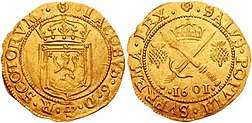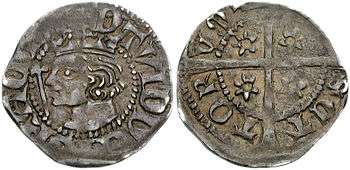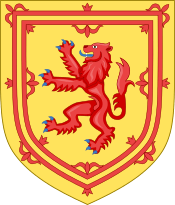Pound Scots
| Pound Scots | |
|---|---|
|
Pund Scottis (Middle Scots) Punnd na h-Alba (in Scottish Gaelic) | |
 Gold "Unite" coin of 1601, worth 1 pound Scots | |
| Denominations | |
| Subunit | |
| 2⁄3 | merk |
| 1⁄20 | shilling |
| 1⁄240 | Penny Scots |
| Plural | pounds |
| Symbol | £ |
| shilling | s. |
| Penny Scots | d. |
| Demographics | |
| User(s) | Kingdom of Scotland |
| Issuance | |
| Mint | See Mints of Scotland |
|
This infobox shows the latest status before this currency was rendered obsolete. | |
| David II (1329–1371): penny | |
|---|---|
 | |
| +DAVID DEI GRACIA, crowned head left; sceptre before | [REX] SCT TOR Vm+, long cross; mullets in quarters. |
| 18mm; 1.31 g; circa 1351–1357. | |
The pound Scots (Modern Scots: Pund Scots, Middle Scots: Pund Scottis) was the unit of currency in the Kingdom of Scotland before the kingdom unified with the Kingdom of England in 1707. It was introduced by David I, in the 12th century, on the model of English and French money, divided into 20 shillings, each of 12 pence. The Scottish currency was later debased relative to sterling and, by the time of James III, the pound sterling was valued at four pounds Scots.
In addition to the pound Scots, silver coins were issued denominated in merk, worth 13 shillings 4 pence (two-thirds of a pound Scots). When James VI became King James I of England in 1603, the coinage was reformed to closely match that of England, with 12 pounds Scots equal to the pound sterling.[1] No gold coinage was issued from 1638 to 1700, but new silver coinage was issued from 1664 to 1707.[2]
In 1707, the pound Scots was replaced by the pound sterling at a rate of 12 to 1 (1 pound Scots equal to 1s 8d sterling), although the pound Scots continued to be used in Scotland as a unit of account for most of the 18th century.
Today there is no distinct Pound Scots; but Scotland's three largest clearing banks (the Royal Bank of Scotland, the Bank of Scotland and the Clydesdale Bank) still print paper notes denominated in pounds sterling. These notes may be accepted as payment throughout the United Kingdom, but are much more commonly seen in Scotland; they represent the same Pound Sterling value as do Bank of England notes in England and Wales.
In 2015 the New Economics Foundation think tank, in association with Common Weal, published a sixty four page report recommending the introduction of a digital Pound Scots, following inspiration from other digital currencies like Bitcoin and local currencies like the Brixton pound.[3] The suggestion was supported by a number of SNP MSP's and MP's including George Kerevan, MP for East Lothian.[4] The report recommended the digital "ScotPound" be implemented via an "arms length public" bank, and that use of the ScotPound could be encouraged via a small payment to every Scottish household. Despite enthusiasm from members of the Scottish government such a project has yet to be launched. A private enterprise however has started a project similar to the proposed ScotPound called "ScotCoin"[5]
List of coins of the pound Scots
- Pistole – Gold, 12 pounds Scots
- Dollar – Replacement for the ryal, 60 Scots shillings (James VI)
- Ryal – Gold, 1565
- Crown or Lion – Gold (James I)
- Half-crown, Demi-Lion or Demys – Gold (James I)
- Ducat or "bonnet" – 40 shillings, 1539 (James V)
- Mark or merk – Gold (giving rise to the term markland)
- Noble – Gold, worth half a mark, 1357 (David II, reintroduced by Robert III)
- Unicorn – Gold, 18 shillings Scots, 1484–85 (James III)
- Half-unicorn – Gold, 9 shillings Scots (James IV)
- Testoun – silver, 1553. Was produced in France with the new process of mill and screw, being the first milled coinage of Scotland.[6]
- Bawbee – Billon, six pence[2] from 1537
- Shilling
- Groat – Silver, equivalent to four pence, from 1357 (giving rise to the term groatland)
- Half-groat – Silver, equivalent to two pence, from 1357
- Turner – Billon, two pence (James VI), later copper.
- Bodle – Copper, two pence[2] (Charles II)
- Hardhead – also called Lion, billon coin circulated in the reigns of Mary and James VI
- Penny – Billon, one of the earliest coins, dating from David I. Later made of copper, giving rise to the term pennyland.
- Halfpennies – Initially literally half of a penny, these became minted coins in their own right in c.1280. Later made of copper.
- Farthing or quarter-penny – These were originally quarters of pennies, but as with Halfpennies, became coins in their own right in c.1280. Later made of copper.
- Plack – value of four Scots pennies or by 1707 one-third of an English penny.
See also
References
- ↑ Meikle, Maureen. "Review of "Prices, Food and Wages in Scotland, 1550-1780". Albion: A Quarterly Journal Concerned with British Studies. North American Conference on British Studies (subscription required). 27 (4): 724. JSTOR 4052591.
- 1 2 3 Hoblyn, Richard (1879). "MILLED SCOTTISH COINS : 1637—1709". The Numismatic Chronicle and Journal of the Numismatic Society. Royal Numismatic Society (subscription required). 19: 113–114. JSTOR 42679414.
- ↑ http://neweconomics.org/2015/09/scotpound-digital-currency-for-the-common-good/
- ↑ http://www.ibtimes.co.uk/scottish-bitcoin-snp-mp-urges-introduction-national-digital-currency-scotpound-1524312
- ↑ https://www.commonspace.scot/articles/8816/scotcoin-meet-scotlands-digital-currency-trading-pub-near-you
- ↑ Stewart: The Scottish Coinage
